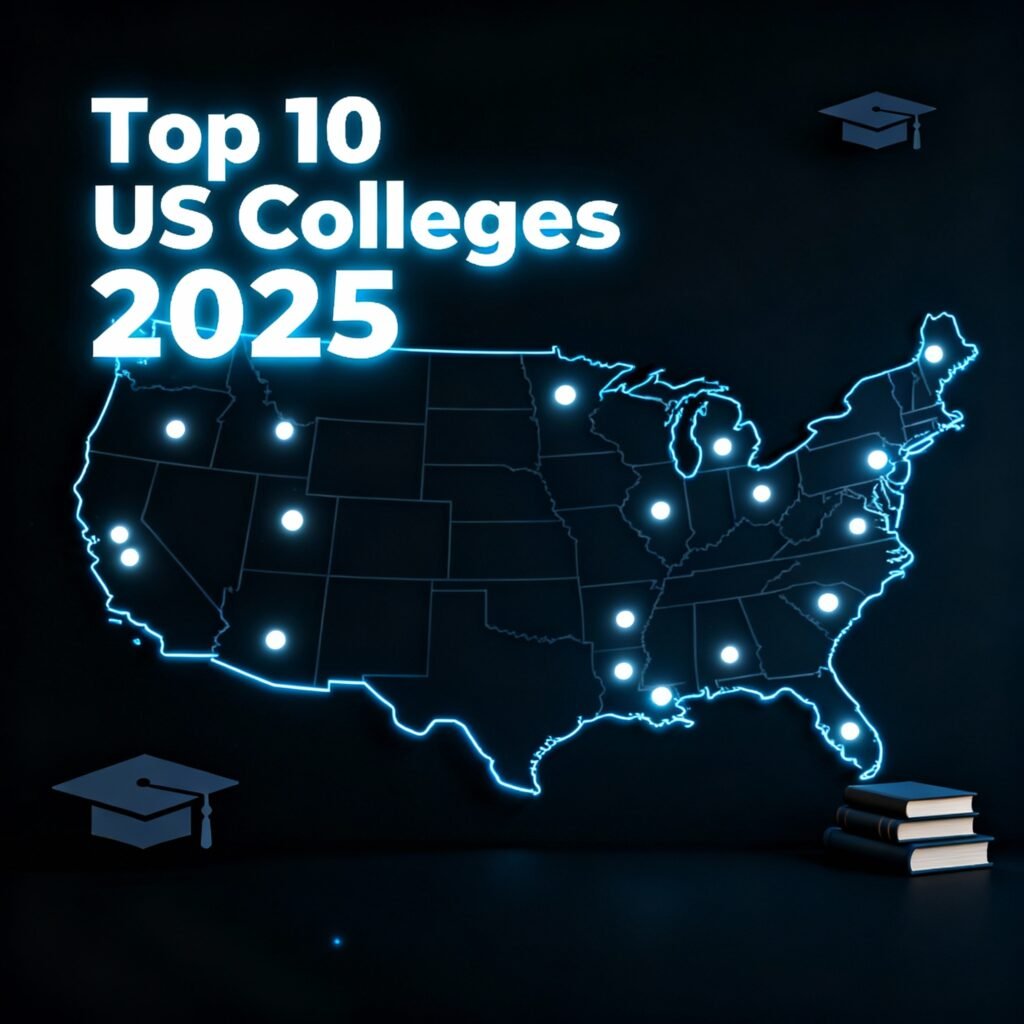
Index
- Introduction
- How to pick a college: Beginner → Expert guide
- Top 10 U.S. Colleges (profiles + links + metrics)
- Comparisons: strengths, costs, research reputation
- Application strategy: step-by-step plan
- Financial aid, scholarships & affordability
- How to prepare as a high school student — roadmap
- Mistakes to avoid & tips for success
- FAQ
- Conclusion & next steps
1. Introduction
Choosing a college in the U.S. is one of the most consequential decisions a student will make. With thousands of institutions, a few elite universities stand out for academic rigor, research, alumni networks, and global reputation. In this guide, you’ll learn:
- What criteria to use (fit, cost, strength)
- How to move from being a beginner (just exploring) to an expert (having a refined short-list)
- Detailed profiles of the top 10 U.S. colleges (with official website links)
- Strategies for applications, financial aid, and preparation
2. How to Pick a College: Beginner → Expert Framework
To make a smart decision, treat selecting a college as a multi-stage process:
| Stage | Focus | Questions to Ask | Action Items |
|---|---|---|---|
| Beginner (Exploration) | Understand your priorities | What field do I like? Prefer urban vs rural? Public vs private? | Create a list of 20–30 colleges |
| Intermediate (Filtering) | Compare criteria | What’s the academic strength? Cost? Location? Student life? | Narrow down to 8–12 colleges |
| Advanced (Deep Dive) | Detailed research | What’s my chance of admission? What’s financial aid? What’s culture? | Pick 3–5 final choices and apply |
Key Dimensions to Compare
- Academic reputation & strength in your desired field
- Faculty, research opportunities, labs, publications
- Selectivity and acceptance rate
- Cost, net price, student debt outcomes
- Campus culture, student body, location, class size
- Internship / job placement / alumni network
As you move from exploration to expert, your understanding deepens, and your list refines.
3. Top 10 U.S. Colleges (profiles + website links + metrics)
Below are ten of the most prestigious U.S. colleges (often found near the top of rankings such as U.S. News, Times Higher Education, QS). Note: rankings shift year to year; use this as a strong reference, not an absolute.
1. Harvard University
- Website: https://www.harvard.edu/
- Location: Cambridge, Massachusetts
- Overview & Strengths: One of the oldest and most prestigious Ivy League institutions. Strong in liberal arts, business (Harvard Business School), law, medicine, and research across disciplines.
- Selective rate / metrics: Harvard’s acceptance rate is usually below 5%.
- Research & Facilities: Massive endowment, world-class libraries, labs, cross-disciplinary institutes.
- Alumni & Network: Global influence, top placements in government, academia, business.
2. Massachusetts Institute of Technology (MIT)
- Website: https://www.mit.edu/
- Location: Cambridge, Massachusetts
- Overview & Strengths: Globally renowned for STEM fields (engineering, computer science, physics, robotics). Also strong in economics, management.
- Selectivity: Highly competitive (single-digit acceptance).
- Research: Leading in innovation, startups, labs.
- Culture: Intense academically, collaborative research focus, entrepreneurial.
3. Stanford University
- Website: https://www.stanford.edu/
- Location: Stanford, California (Silicon Valley)
- Overview & Strengths: Strong across STEM, business, humanities, medicine. Exceptional innovation and link to tech industry.
- Selectivity: Very high competitiveness.
- Edge: Proximity to Silicon Valley, startup culture, strong funding & entrepreneurship ecosystem.
4. Princeton University
- Website: https://www.princeton.edu/
- Location: Princeton, New Jersey
- Overview & Strengths: Ivy League with strong undergrad focus, especially in research, humanities, natural sciences, math.
- Selectivity: Very low acceptance, strong emphasis on academic excellence.
- Undergrad Experience: Smaller classes, strong advising, generous financial aid.
5. Yale University
- Website: https://www.yale.edu/
- Location: New Haven, Connecticut
- Overview & Strengths: Strong in liberal arts, law, drama, humanities, interdisciplinary research.
- Selectivity & Aid: Very competitive, with generous financial aid programs.
- Culture: Strong arts and culture presence, research opportunities for undergrads.
6. California Institute of Technology (Caltech)
- Website: https://www.caltech.edu/
- Location: Pasadena, California
- Overview & Strengths: Small, elite, focused on science and engineering. High faculty-to-student ratio.
- Selectivity: Extremely competitive; rigorous STEM curriculum.
- Research: Significant in astrophysics, planetary science, engineering, quantum science.
7. University of Chicago
- Website: https://www.uchicago.edu/
- Location: Chicago, Illinois
- Overview & Strengths: Known for rigorous academics, economics, social sciences, law, and strong research culture.
- Selectivity: Very selective; intellectual culture, challenge-based education (Core).
- Reputation: Emphasis on critical thinking, deep inquiry.
8. Columbia University
- Website: https://www.columbia.edu/
- Location: New York City, New York
- Overview & Strengths: Ivy League in the heart of NYC. Strong in journalism, arts, sciences, business.
- Selectivity: Very high; draws global applicants.
- Edge: NYC advantages, connections, internships, global exposure.
9. University of Pennsylvania (Penn)
- Website: https://www.upenn.edu/
- Location: Philadelphia, Pennsylvania
- Overview & Strengths: Ivy League with strong business (Wharton School), social sciences, biomedical, interdisciplinary programs.
- Selectivity & Aid: Competitive, with focus on interdisciplinary education.
- Strength: Blending liberal arts + professional studies.
10. Duke University
- Website: https://www.duke.edu/
- Location: Durham, North Carolina
- Overview & Strengths: Strong across sciences, medicine, law, interdisciplinary studies, research.
- Selectivity: Highly selective, growing in prestige.
- Culture & Research: Strong student engagement, global programs, research funding.
Note: The above list is based on longstanding reputations, commonly recurring in top U.S. rankings. You should cross-check current ranking lists (e.g., U.S. News, QS, Times Higher Education) for the latest ordering.
4. Comparisons: Strengths, Costs, Research Reputation
| University | Strength Areas | Estimated Annual Cost (Tuition + Fees)* | Unique Selling Proposition |
|---|---|---|---|
| Harvard | Broad excellence, leadership, law, medicine | ~$55,000+ (before aid) | Ivy prestige, global alumni, endowment |
| MIT | Engineering, CS, innovation | ~$57,000+ | Cutting-edge tech, entrepreneurship |
| Stanford | Tech, business, research | ~$57,000+ | Silicon Valley advantage |
| Princeton | Research + undergrad focus | ~$54,000+ | Focus on scholarship, smaller community |
| Yale | Liberal arts, drama, humanities | ~$57,000+ | Culture, arts, research for undergrads |
| Caltech | Physics, engineering, science | ~$58,000+ | Exceptionally high faculty engagement |
| UChicago | Economics, social sciences | ~$58,000+ | Core curriculum, deep inquiry |
| Columbia | Journalism, arts, sciences | ~$60,000+ | NYC exposure, global prestige |
| Penn | Business (Wharton) + liberal arts | ~$60,000+ | Interdisciplinary edge, business strength |
| Duke | Medicine, research, liberal arts | ~$59,000+ | Growing research power, student life |
*Costs vary with residency, aid, living expenses; always verify current numbers at official websites.
Research & Publication Strength:
These institutions publish heavily, receive major grants (e.g., NIH, NSF), maintain top-tier labs, and attract global faculty. For students, that means access to cutting-edge work, funding, and mentorship.
5. Application Strategy: Step-by-Step Plan
To maximize your chances:
Step 1: Early Research (Junior Year of High School)
- Explore fields you like, campuses, costs
- Visit campuses (in person or virtually)
- Talk to alumni, current students
Step 2: Build a Strong Profile
- High GPA / rigorous coursework (AP, IB, honors)
- Extracurriculars (leadership, depth, consistency)
- Community service, internships, projects
- Standardized test scores (if required)
Step 3: Take Tests & Prepare Materials
- SAT / ACT / optional tests
- AP / IB / subject tests
- Essays / personal statements
- Letters of recommendation
- Portfolio / auditions (if applicable)
Step 4: Shortlist & Apply
- Use the filtering steps from section 2
- Apply “reach, target, safety” mix
- Meet deadlines (Early Action, Regular, Rolling)
- Submit applications via common platforms (e.g., Common App)
Step 5: Prepare for Interviews & Waitlist
- Some colleges have interviews
- Be ready to explain “why us”
- If waitlisted: send updates, additional materials
Step 6: Decision & Enrollment
- Compare financial aid offers
- Choose the best fit (academics + culture)
- Confirm & enroll
6. Financial Aid, Scholarships & Affordability
Types of Financial Aid
- Need-based aid: grants, scholarships based on family income
- Merit-based scholarships: awarded for excellence (academic, sports, arts)
- Work-study / campus jobs
- External scholarships / contest awards
Tips to Maximize Aid
- Fill out FAFSA / CSS Profile early
- Apply for institutional scholarships (colleges often have their own)
- Apply for external scholarships (local, national)
- Maintain strong grades & extracurriculars
- Appeal for better aid if initial offer is low
Net Price Calculator
Most colleges provide a “net price calculator” on their websites — use it early to estimate actual cost after aid.
7. How to Prepare as a High School Student — Roadmap
| Grade | Focus | Activities |
|---|---|---|
| 9th | Exploration & foundation | Strong grades, explore interests, join clubs |
| 10th | Build profile | Advanced classes, leadership roles, summer programs |
| 11th | Test preparation & deepening | Take SAT/ACT, AP/IB, internships, start essays |
| 12th | Final push & apply | Finalize essays, secure recommendations, submit applications |
Summer before senior year: Do research, internships, projects, subject camps, or online coursework related to field of interest.
8. Mistakes to Avoid & Tips for Success
Common Mistakes
- Focusing only on “brand name” schools instead of fit
- Ignoring costs & debt implications
- Weak essays (too generic or lacking personal voice)
- Submitting late, or missing deadlines
- Not applying to safety schools
- Relying solely on merit aid without exploring need-based
Pro Tips
- Visit or virtually tour campuses
- Connect with current students or alumni
- Show “trajectory” (improvement, depth in interest)
- Use storytelling in essays — unique voice wins
- Follow up thank-you notes for recommenders, interviews
- Diversify your options (academic reach, safety, sure things)
9. FAQ
Q: Are these “top 10” always the same?
A: No — rankings evolve. But the ones listed are consistently present in most top lists (e.g., U.S. News, QS). Use them as benchmarks, not absolutes.
Q: How important is undergrad research?
A: Very. Getting early exposure to research, publications, or labs can significantly boost grad school or job prospects.
Q: Is a U.S. college worth it for international students?
A: It depends. High prestige, network, and opportunities exist, but cost and visa rules must be weighed carefully. Scholarships and merit aid are critical.
Q: Should I focus only on Ivy League schools?
A: No. Many excellent non-Ivy colleges (state universities, liberal arts) offer outstanding education and value. Fit matters more than brand.
10. Conclusion & Next Steps
- Use the beginner → expert framework to refine your shortlist.
- Dive into the detailed profiles above and visit official college websites.
- Work on a strong academic & extracurricular profile.
- Plan for financial aid early.
- Use this guide as a foundation — supplement with up-to-date data (acceptance rates, costs) from the colleges themselves.

